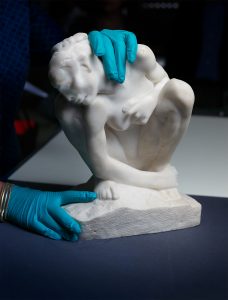The find of the Gurlitt art trove five years ago was a sensation. Now, a “Status Report” in the form of an exhibition leaves key questions unanswered…
Keeping things secret is the best way to keep them safe,” said Munich customs official Siegfried Klöble in 2013, one and a half year after the discovery of the Gurlitt trove. When the public learnt about the 1,500 works of art found in the homes of Cornelius Gurlitt, all kinds of speculations were raised. Initial estimates placed their total value at more than $1 billion. Gurlitt died in 2014, leaving behind a tangle of questions about the vast art collection amassed by his father under the Nazis. In the past few years, only few answers have been found. The Gurlitt task force, a group of German researchers, has been trying to clarify the origins of what has been called the biggest artistic find of the postwar era. The task force has faced much criticism over the slow pace of the investigation. So far, the experts have been able to identify the former owners of only six paintings. The international sensation has been replaced by both discontent and more serious research on looted art.

Auguste Rodin: The Crouching Woman
Kunst-und Ausstellungshalle der Bundesrepublik Deutschland GmbH / Photo: Albrecht Fuchs
This fall, an exhibition at Martin Gropius Bau in Berlin presents about 250 works of art from the Gurlitt collection, which belonged to the German museum professional and art dealer Hildebrand Gurlitt (1895–1956), Cornelius Gurlitt’s father. Organized by the Bundeskunsthalle Bonn and Kunstmuseum Bern, Gurlitt: Status Report focuses on the campaign against ‘degenerate art’ and on the Nazi regime’s Europe-wide theft of cultural assets. It spans a wide range of eras and styles – from Dürer to Monet and from Cranach to Kirchner and Rodin. By shedding light on the provenance of each of the works on show, the exhibition also presents the complex history of the individual objects. For example Portrait of a Seated Young Woman by Thomas Couture, which has been identified as Nazi-looted art in 2017, belonged to one
of the most famous French victims of the Nazi regime, the high-ranking Jewish politician and anti-Nazi Georges Mandel.
The Gurlitt case draws attention to the role of the art trade within the criminal Nazi regime and to the fact that Hildebrand Gurlitt benefitted enormously from the gradual disenfranchisement, dispossession and despoliation of Jews in Europe. “As an art historian, Hildebrand Gurlitt championed the art of the avant-garde, but as an art dealer, he tendered his services to the Nazi regime,” explain the curators. “The provenances of the works shown here clearly demonstrate that he had no qualms about their often problematic origin.” The exhibition depicts Hildebrand Gurlitt as a man who was prepared to exploit every aspect of Nazi policy to personally enrich himself.
The exhibition comprises works confiscated as ‘degenerate’ from German museums in 1937/38 as well as works whose origins remain to be identified. Some of the latter are under suspicion of having been seized as a result of Nazi persecution and of being Nazi-looted art. The exhibition also sheds light on the fate of some of the previous owners – most of them Jewish collectors or art dealers. “Their stories appeal to our political and moral obligation to address the issue of Nazi-looted cultural assets and their history in public and private collections with sensitivity
and respect,” the organizers emphasize.

Bernhard Kretzschmar: Streetcar
VG Bild-Kunst, Bonn 2018
To facilitate the investigation of the provenance of the individual works and safeguard the transparency of the process, the suspect works were registered on the Lost Art Database. In most cases, however, the provenance has not yet been verified. This applies for example to Straßenbahn (Streetcar) by Bernhard Kretzschmar (1889–1972), a founding member of the Neue Dresdner Sezession in 1932. His art was regarded as ‘degenerate’ during National Socialism. While the exhibition doesn’t unravel the mysteries of the reclusive Cornelius Gurlitt and his enigmatic father Hildebrandt, it sheds light on modernist artists whose achievements have as yet not been completely explored and investigated. Still, Gurlitt: Status Report remains unfinished business.
Gurlitt: Status Report is on show at Martin Gropius Bau Berlin until 7 January 2019
